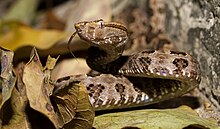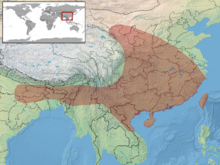| Brown-spotted pit viper | |
|---|---|

| |
| Scientific classification | |
| Domain: | Eukaryota |
| Kingdom: | Animalia |
| Phylum: | Chordata |
| Class: | Reptilia |
| Order: | Squamata |
| Suborder: | Serpentes |
| Family: | Viperidae |
| Genus: | Protobothrops |
| Species: | P. mucrosquamatus
|
| Binomial name | |
| Protobothrops mucrosquamatus (Cantor, 1839)
| |

| |
| Synonyms | |
| |
Protobothrops mucrosquamatus is a venomous pit viper species endemic to Asia. Common names include: brown-spotted pit viper,[4] Taiwanese habu and pointed-scaled pit viper.[5] No subspecies are currently recognized.[6] The species was first described by Theodore Cantor in 1839.[7]
- ^ Papenfuss, T.J. (2010). "Protobothrops mucrosquamatus". IUCN Red List of Threatened Species. 2010: e.T178409A7540882. doi:10.2305/IUCN.UK.2010-4.RLTS.T178409A7540882.en. Retrieved 20 November 2021.
- ^ McDiarmid RW, Campbell JA, Touré T. 1999. Snake Species of the World: A Taxonomic and Geographic Reference, Volume 1. Herpetologists' League. 511 pp. ISBN 1-893777-00-6 (series). ISBN 1-893777-01-4 (volume).
- ^ Cite error: The named reference
RDBwas invoked but never defined (see the help page). - ^ Gumprecht A, Tillack F, Orlov NL, Captain A, Ryabov S. 2004. Asian Pitvipers. Geitje Books. Berlin. 1st Edition. 368 pp. ISBN 3-937975-00-4.
- ^ U.S. Navy. 1991. Poisonous Snakes of the World. US Govt. New York: Dover Publications Inc. 203 pp. ISBN 0-486-26629-X.
- ^ "Trimeresurus mucrosquamatus". Integrated Taxonomic Information System. Retrieved 25 May 2007.
- ^ Alves, R.R.N.; Rosa, I.L. (2012). Animals in Traditional Folk Medicine: Implications for Conservation. Life sciences. Springer Berlin Heidelberg. p. 116. ISBN 978-3-642-29026-8. Retrieved 9 June 2019.
